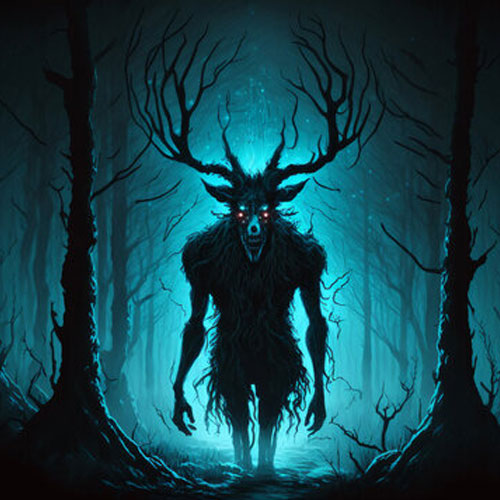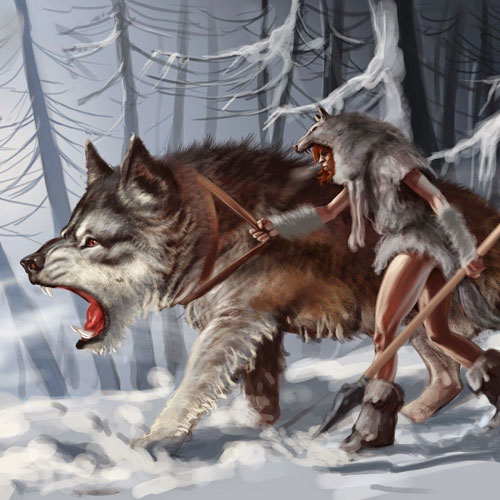Mythical Beings from Indigenous Lore
This group includes cryptids that have been part of Indigenous lore and mythology for generations. These creatures are often associated with spiritual beliefs and cultural practices. They represent the deep connection between the land, the people, and the stories that have been passed down through the ages.
Wendigo
The Wendigo is a creature from the folklore of the Algonquin-speaking tribes of North America. It is described as a malevolent spirit or monster that preys upon humans, particularly those who have committed acts of greed or cannibalism. The Wendigo is said to have a heart of ice and a body that is skeletal and emaciated, with glowing eyes and sharp teeth.
Adlet
The Adlet is a creature from Inuit mythology that is said to have the upper body of a human and the lower body of a dog or wolf. According to legend, the Adlet were born when a woman mated with a dog. They are described as fierce hunters and warriors, and are said to have supernatural strength and agility.
Qallupilluk
The Qallupilluk is a creature from Inuit mythology that is said to live in the waters of the Arctic. It is described as a humanoid creature with green skin, long hair, and long claws. The Qallupilluk is said to prey on children who venture too close to the water’s edge, dragging them underwater to drown them.
Tsinquaw
The Tsinquaw is a terrifying Canadian cryptid that has been reported in the area around Cochiwan Lake. It is said to be a large serpent-like creature with a long neck and a head resembling that of a horse. According to local First Nations, the Tsinquaw is known to attack and devour humans who venture too close to its habitat.
Mysterious Creatures of the Deep
This group consists of cryptids that are said to inhabit the waters surrounding Canada. These creatures are often shrouded in mystery and have been the subject of many stories and legends. They are elusive and difficult to spot, adding to the intrigue and fascination surrounding them.
Ogopogo
Ogopogo is a cryptid that is said to inhabit the depths of Okanagan Lake in British Columbia. It is often described as a giant serpent or eel-like creature, with sightings dating back to the early 1800s. While some claim it is a myth, others believe it to be a real, flesh-and-blood creature that continues to evade detection and capture.
Shuswaggi
Shuswaggi, also known as the Shuswap Lake Monster, is a legendary creature said to inhabit the depths of Shuswap Lake in British Columbia. It is often said to resemble a large, serpentine creature with a horse-like head and scaly skin. Some eyewitnesses have claimed to see a hump or series of humps moving across the water’s surface.
Seelkee
Seelkee is a cryptid that is said to inhabit the coastal regions of British Columbia. It is described as a creature with the body of a seal and the head of a dog or wolf. While some believe it to be a myth, others suggest it may be a type of unknown marine mammal.
Mishipeshu
Mishipeshu is a cryptid that is said to inhabit the Great Lakes region of Canada and the United States. It is described as a creature with the body of a large cat or panther, the horns of a deer, and scales like a fish or serpent. While some believe it to be a myth or legend, others suggest it may be a type of unknown species that has yet to be discovered.
Terrifying Beasts of the Land
This group includes cryptids that are feared for their size, strength, and ferocity. They are said to roam the forests, mountains, and plains of Canada, striking fear into the hearts of those who encounter them. Their stories often involve violent attacks and supernatural abilities.
Wapaloosie
The Wapaloosie, also known as the Weewalker, is a cryptid from the folklore of the Kwakwaka’wakw First Nations people of British Columbia. It is described as a furry, worm-like animal with numerous legs that allow it to climb trees with ease. Some have described it as being similar in appearance to a large caterpillar or centipede.
Waheela
A creature of Inuit mythology, the Waheela is described as a large, white wolf-like creature with long, sharp claws and powerful jaws. It is said to roam the tundra and mountains of northern Canada, and is feared by the Inuit people as a dangerous and malevolent spirit.
Kiidk’yaas
Also known as the “Golden Spruce,” this cryptid is said to be a tree that is imbued with supernatural powers. According to legend, the tree is inhabited by the spirit of a young Haida boy who was transformed into a tree by the gods as a punishment for his arrogance.
Canadian Chupacabra
This canine-like creature resembles the legendary Chupacabra of Latin American folklore. It has been reported in various parts of Canada, with sightings as recent as the Bowen Island incident in 2008. Witnesses describe it as having sharp fangs, leathery skin, and a fierce demeanor.
Great White North Terrors
This group consists of cryptids that are said to dwell in the harsh and unforgiving environments of the Arctic regions of Canada. These creatures are adapted to the extreme conditions of their habitat and are feared for their ability to survive and thrive in such a hostile environment.
Giant Polar Bear
The Giant Polar Bear is a legendary creature reported in the Northwest Territories. This cryptid is described as a massive polar bear that towers over its brethren, reaching up to 10 feet tall when standing on its hind legs. While sightings of these creatures are rare, there have been several reports from Inuit hunters and other locals over the years.
Dire Wolf
The Dire Wolf is a prehistoric species of wolf that once roamed North America during the Pleistocene era. It was a larger and more robust relative of the modern gray wolf, with a powerful build and strong jaws. Despite being thought to have gone extinct around 10,000 years ago; there are still yearly sightings in the most Northern part of the Mackenzie Valley.
Rougarou
The Rougarou is a mythical creature from French-speaking regions of North America, particularly the Northern part of Quebec. It is said to be a werewolf-like creature with the ability to shift from human to wolf form. According to legend, the Rougarou is a cursed individual who must hunt and kill for 101 consecutive days before the curse will be lifted.
Partridge Creek Monster
The Partridge Creek Monster is a legendary creature said to inhabit the remote wilderness of the Yukon. While sightings of the creature are rare, there have been numerous reports from hunters and other outdoors enthusiasts over the years. Some speculate that the monster is a surviving specimen of the prehistoric bear species known as the short-faced bear.
British Columbia’s Bizarre Lifeforms
British Columbia is known for its rich biodiversity and unique wildlife, including a plethora of strange and unusual creatures that are said to inhabit its forests and waterways. From elusive forest spirits to terrifying lake monsters, these bizarre lifeforms have captured the imaginations of Canadians for generations.
Sasquatch
British Columbia is perhaps most famously known for being home to the Sasquatch, or Bigfoot, one of the most enduring and elusive creatures of cryptozoology. Sightings of these massive, hairy creatures have been reported for centuries, and although there is little scientific evidence to support their existence, they remain a fixture of British Columbian folklore and popular culture.
Giant Raven
The Giant Raven is often reported in the forests of British Columbia. These black-feathered birds with a striking red tail are said to be significantly larger than their common counterparts, with some sightings describing them as having wingspans of up to 10 feet. These intelligent creatures are often associated with the creation stories of the first nations and are thought to be spiritual guides and messengers.
Giant Spiderbat
The Giant Spiderbat is an elusive cryptid reported to reside in the forests of British Columbia. These creatures are said to have a body resembling that of a spider with eight legs, but with the wings of a bat. Witnesses have reported seeing these creatures roosting in trees during the day and hunting for prey at night. It is said that they have a venomous bite that they use to incapacitate their prey before feeding on them.
Black Alligator
The creature’s name is believed to be a mistranslation from the Salish language, as it shares many similarities with giant black salamanders. Sightings of the creature have been reported near hot springs in British Columbia, leading some to believe that it may be an endemic species to the region. The creature is described as being large and black, with a long tail and a reptilian appearance.






















